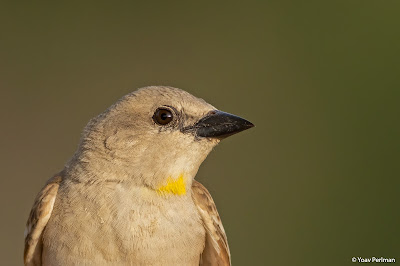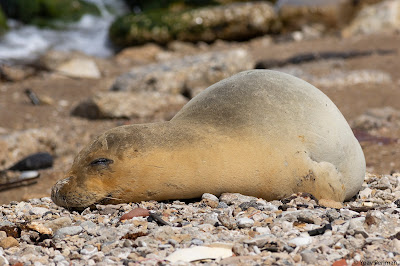Yesterday I spent the morning on Mt. Hermon, working there with INPA and Nadav to better protect the precious ecosystem of the mountain, threatened by further development by the military and the ski resort. It's incredible that one of Israel's most unique and precious ecosystems is only partially protected. Anyway, the gate leading up to the mountain opens up only at 07:30. What to do during the two hours of light before 07:30? I spent them along the Petroleum Road, in search of Yellow-throated Sparrows that had returned for another breeding season. When I arrived on site, I was happily surprised to find there Yosef Kiat, doing what he normally does... Perfect timing for me. We quickly saw a male sparrow singing high up on wires, and in no time it was in the hand, allowing close examination of its subtle but wonderful plumage.
Tuesday, May 30, 2023
They're back!
Monday, May 15, 2023
Oh Julia
Sunday, May 14, 2023
Global Big Day May 2023
Yesterday was Global Big Day, organised by eBird, part of World Migratory Bird Day and Global Birding Weekend events. It was an unusual big day for me, because for the first time in several years I didn't do a proper big day - I had a good reason though (see below). Also, our third team member Re'a made a bunk, so it was just Jonathan and me. We decided to spend the morning around birdy Kfar Ruppin - possibly the most productive place to spend a morning birding this time of year, when migration is dwindling here. Hey World Migratory Bird Day and eBird - please shift the date one week earlier (first weekend of May rather than second) so more southerly countries could enjoy good migration too. Thanks!
We left early, Jonathan did his story things, and we arrived at Kfar Ruppin nice and early, in time for a good coffee and fresh dawn birding. Kfar Ruppin fishponds, where we have our restoration project with the kibbutz, are so amazing. This specific reservoir has held low water levels, and amazing bird levels, for several months now.
The morning ended too quickly and we had to drive back home, adding some random stuff on the way back. Our morning total was 97 species, poor for a big day but quite OK (I think) for a concentrated four-hour effort. Had we done a full big day, that would have been a decent start.
The reason I headed back so early, abruptly cutting short my big day effort, had to be dramatic. I headed back for the premiere of a new documentary movie, Observation Diary, part of the documentary movie festival Doc Aviv. It's a beautiful movie, created and directed by the talented Itay Marom. The movie follows the birding diaries of the late Amit Geffen, a young and talented birder whom I had the honour and pleasure to guide, mentor and work with until he passed away in 2007, at the tender age of 21. I was fortunate to participate in the movie, and there is even lovely footage of my late dog Bamba, out birding with me. Several friends - Nadav, Yael, Nimrod and others also take part in the movie.
The premiere was awesome - it was a powerful experience, to share the experience with so many people. Everyone involved in the movie were very excited - I have so much appreciation and gratitude towards Itay, Idit and their team for giving me the opportunity to take part in such a beautiful project. This is Udi, Amit's dad, and me at the premiere - photo taken by my son Uri.
Friday, May 5, 2023
My favourite bird?
I often get asked what is my favourite bird. As a professional birder, I find this question impossible to answer. I appreciate a Willow Warbler as much as I appreciate a Wandering Albatross. I find Garden Warbler to be a very pretty bird, just as pretty as a European Bee-eater. Trying to understand the unique ecological position of each and every species in the complex web of life on earth, every organism has its role and importance. Further, I think I comprehend some of the huge challenges birds are facing, whether they are long-distance migrants or residents. However, there are a few species that I have dedicated more time to study and understand them better, and protect them. Nubian Nightjar is one of those species. Not sure whether I can call it my favourite birds - certainly it's the bird species I know most intimately, and have invested most time on. Admittedly, it's a very fine bird.
Since I studied the Sdom Saltmarsh Nubian Nightjars for my MSc research at Ben Gurion University in 2004-2006, I have been deeply involved in the conservation of their habitat. I am very proud that as a result of a concentrated team effort, most of the remaining habitat of the species' stronghold, in Sdom Saltmarsh, has recently been declared as a nature reserve, and will remain protected forever, I hope.
My current job as director of BirdLife Israel includes significant managerial components. However, I kept some fieldwork components in my job, especially in projects or areas that are most important to me. Such is the Nubian Nightjar monitoring that I do every year around this period, around a full moon, trying to assess the population status of the threatened species.
Last night was part 1 of my monitoring effort in Sdom Saltmarsh. I headed down with Rotem, a keen young birder who is starting to work with us. Before dusk we had time for a quick look at Ashalim Reservoir. It was too dark for photography but the birds were active and it was fun. Seven African Swamphens, including two recently-fledged young, first families of Ferruginous Ducks, Blue-cheeked Bee-eaters, a large roost of Sand Martins - I love this site, even before the Sooty Falcons return.
After dusk we started working, counting nightjars that are super active when the moon is strong, like last night. Conditions were perfect - very powerful moonlight, warm temperatures, very still, good flying insect activity. We covered about half of the relevant habitat, and counted 71 vocal males! I cannot be certain that these 71 vocal males represent 71 active breeding territories - in fact we had visual contact with only a handful of nightjars. One of them did pose briefly - super nice. Check that superb rufous collar.
At some points we found a very high density - up to six birds vocalising around us. I will complete the second half of habitat soon to conclude the numbers for 2023. However, with the current density, I assume the numbers will be similar to the high numbers recorded in 2020.
Other random birds we had during the night were singing Scops Owl, Rufous-tailed Scrub-Robin and Little Bittern. We also encountered Porcupine, Wild Boar, Golden Jackal and Cape Hare.
Thanks Rotem for the hard work!





















